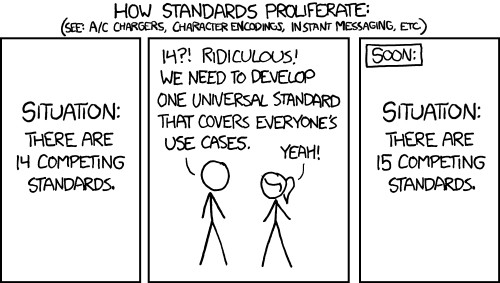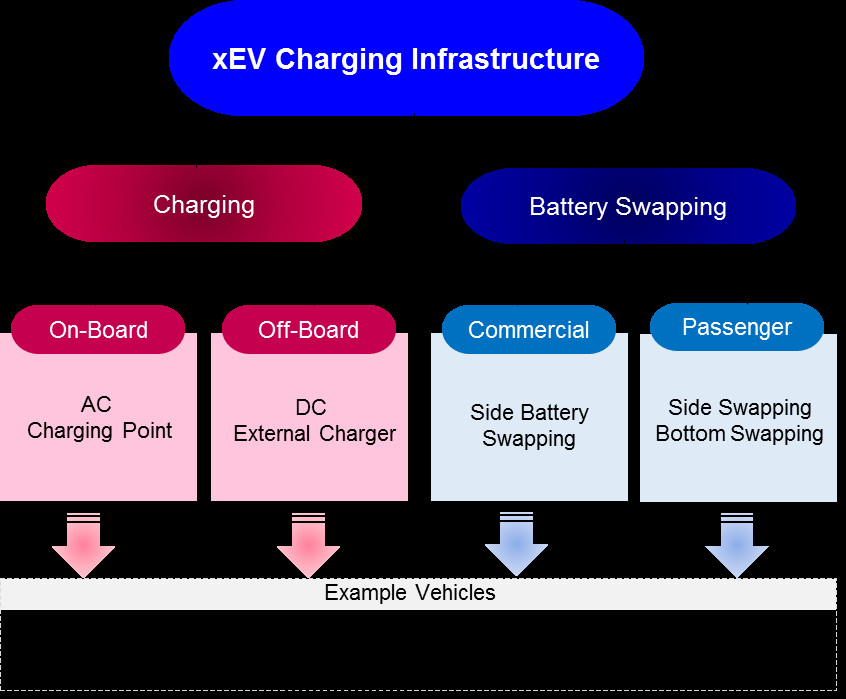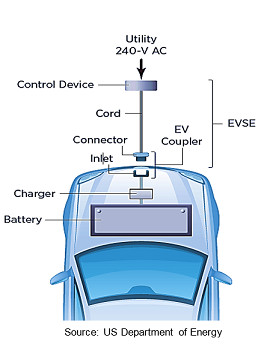Plug-n- Play Part- 1: India’s Roadmap to 100% Electric Mobility by 2030
Plug-n-Play Part -2: Which comes first “Electric Vehicle" or "Charging Infra”
]
Recently the national dailies & digital platforms are flooded with news on theIndian Government’s xEVs focus and push for “No Subsidy” and at the same time huge impetus on “Lowering the Initial Acquisition Cost” to enable mass adoption in the country. This makes it imperative to look at best global practices and blend those with “Fit to India” innovation, that’s the only key to success in our kind of “GLOCAL – Value for Money” market.
Infrastructure always comes before Innovation, viz telecommunication infrastructure has to be there for mass adoption of Internet and Internet had to exist to use web services, 3G telecom towers are required for rapid adoption of smartphones and so is the case with xEVs …… In India we need to look at, if not 100% but near to “Minimum compromise or No Compromise Switch” then the choice is obvious
Referring from my previous article “Which comes first “Electric Vehicle or Charging Infra”, way back in 1910 there were “8000 GE charger’s” also known as “Wattstation”installed for xEVs charging. On the flip side, in these 100 years the industry ecosystem & acceptability of xEVs has tremendously evolved, contrary to the case of charging infrastructure standardisation, globally we still have “Proliferating Standards” and lack of“Uniformity” across, with US, EU, Japan and now China also competing with different charging standards. In India we are at critical point of making choices for charging infrastructure standards. (Pls refer my first Article for Draft Standards released by ARAI Pune “ What comes first " Electric Vehicles" or "Charging Infra"”)
The benefit which ICE (Internal Combustion Engine) vehicle enjoys is that gasoline or petrol/diesel filling nozzles are same across the country and there is no worry of any compatibility challenges, the only difference is the shape & size of nozzles for CNG vs Diesel/Petrol. Undesirably, in case of xEV that’s not the case. In case of DC Fast Charging (DCFC), there are multiple standards competing with each other leading to further fragmenting the already struggling infrastructure Industry. One should definitely want to have the freedom to re-charge at any charging station without any worry of being incompatible with the charging infrastructure. The phrase “Plug-n-Play” is the operative word.
“All the Wood behind one Arrow” A phrase which means focusing all resources on one aim, having different charging standards is opposite. At the outset, there is a uniformity to large extent for slow and medium charging rate charging stations however the whole dis-unity starts in Fast Charging. Nevertheless the story till now have created lot of anxiety pushing me to dive deep to understand the evolution of charging infrastructure.
Variety of charging infrastructure solutions are being piloted or deployed by private companies, governments and public-private partnerships.
- Home Charging
- Fast-Charging or DC Fast Charging
- AC Fast Charging
- Super-Chargers (Tesla Motors propriety network)
- Battery Swapping Stations
- Inductive / Wireless Charging.
With initial deployment of xEVs, several slow and medium speed chargers- what are known as “Level -1” & “Level-2” were deployed followed by a serious need of Fast Charging and it takes us to develop DCFC ecosystem. DC Fast Charging is widely seen as pivotal way to reduce “Range Anxiety” of battery electric vehicles (BEVs) and enable faster adoption of xEVs. Unfortunately DCFC doesn’t enjoy the standardization advantage, it means that one can’t just drive to DCFC station & re-charge.
Historically in case of DC, while fast charging cars were available in 2011 (Nissan Leaf & Mitsubishi i-MiEV), but one of the early & leading DCFC standard, Japan’s CHADeMOdidn’t grew fast. At the same time few of the automakers lobbied against CHADeMO, since it wasn’t SAE endorsed standard, and finally SAE also came up with their own fast charging standard (Combined Charging System) typically known as CCS, so is Tesla Motors “Supercharger” and last but not the least china developed a different charging standard GB/T and today we have FOUR largely known DCFC Standards competing with each other globally.
- CHADeMO
- SAE CCS
- Tesla’s Supercharger
- China’s GB/T.
- India…..? ( Draft Standards released by ARAI Pune & DHI)
You must be wondering about these terms? Let us quickly understand few interesting facts across “Past to Present” evolution of charging infra and standards.
Prior to understand the charging infrastructure, it is imperative that one should know about “Electric Vehicle Supply Equipment (EVSE)”. EVSE is a device which brings AC power to your car, where it then gets converted to DC power by “On-board Charger” and fills up the battery. It is mostly classified based on the communication capabilities & how quickly they can charge a vehicle.
Evolution of US Charging Standards & SAE Terminology
Around 1998, the California Air Resources Board (CARB) classified levels of charging power that later got adopted/notified in SAE International Standards. Society of Automotive Engineers (SAE) is Warrendale US headquartered organisation overseeing the automotive standards. The famous “J1772 Plug” also known as J-Plug is originally a J1772 committee convened by SAE. So now we know from where the name came from?
The most commonly accepted slow and medium speed charge rate standards developed by SAE were Level-1 and Level-2 and refers to AC charging System. These charging standards are most commonly used for Home Charger/ Home Charging Station or sometimes wall charger at public places
Level -1* EVSE: This is the slowest form of charging and provides charging from a typical household (120v) AC plug. Most, if not all PEVs comes with EVSE cord set along, so no additional equipment is required. On one end there is a standard household product and on the other end is J1772 standard connector. Level -1 typically is used when there is only 120 volt outlet available most likely at residential locations. Depending upon the battery type, charger Size & vehicle type Level -1 charging adds about 2-5 miles of range per hour.
Level - 2 EVSE: Level -2 can easily charge xEV battery overnight, it offers charging through 240 volt, it also requires an installation of dedicated charging equipment (EVSE) and a dedicated circuit of 20 to 80 Amp. Level -2 charging adds about 10-20 miles of range per hour. In case of level -2 charging the installation costs are much higher and variable based on equipment and installation issues & at the same time level-2 is most commonly deployed in charging infrastructure
CCS: This is SAE developed DCFC standard & will be covered at a later stage.
IEC 62196: Europe’s Terminology
IEC 62196 plugs, socket outlets, vehicle couplers and vehicles inlets, conductive charging of xEVs is an international standard for electrical vehicles maintained by “International Electrotechnical Commission" (IEC). IEC 62196 is further based on IEC 61851 “Electric Vehicle Conductive Charging System” which established general characteristics both for xEVs and EVSE including charging modes and connection configuration.
Mode- 1: Slow charging from regular household socket (single phase or three phase)
Mode- 2: Slow charging from regular household type socket with some EV specific or in cable protection device.
Mode- 3: Slow or fast charging using specific EV socket with control and protection function installed.
Mode- 4: Fast charging using external charger.
This corresponds well with most commonly used phrases listed above, it also gives some idea on connection configuration cases as shown in the figure below.
For people like us in the street chatting casually or informally, it seems Pandora’s box of different charging terminologies, some of the best phrases to use are given hereunder to make life easier
Going further deep, it’s important that we should have a quick outline on “Plug Types and Signalling” used in the xEV transportation system. IEC 61851 refers to plug & Sockets for Industrial use, specified in IEC 60309 to provide electrical power for modes it specifies. The connectors than got standardised in IEC 62196 and the standard IEC 62196-2 was published by IEC on 13th Oct 2011 and type of plugs/connectors it includes are listed under.
- Type 1: Single Phase Vehicle Coupler ( Reference SAE J1772/2009 Automotive plug, Mostly used in North America Region)
- Type 2: Single & Three Phase Vehicle Coupler (Reflecting VDE-AR-E-2623-2-2, Mostly used in Europe)
- Type 3: Single & Three Phase Vehicle Coupler with Shutters (Reflecting the EV Plug Alliance Proposal)
- Type 4: Direct Current Coupler (Reflecting Japan Electric Vehicle Standard JEVS G105-1993 specifications from JARI
Quick Charging Plug Technical Standards Reckoner Table
Summary & To be Continued in Next Article...
Globally, in last 100 years, xEVs industry has phenomenally evolved both in terms of technology & popularity, contrary to “Charging Infrastructure”. Though largely “UNIFORMITY” has been achieved, especially on slow & medium speed charging infrastructure as well as standards (Level -1 & Level -2), however to enable rapid mass adoption of xEVs, we have come across a long way from technology evolution, wherein one can charge in just 30 min or so using DC Fast Charging.
In case of DCFC, we still have proliferating standards globally with US, EU, Japan and now China competing with each other further fragmenting the industry. While we are still figuring out a way to bring “UNIFORMITY” in DCFC, Industry has already started leapfrogging to Ultra DCFC, with recently first EV Ultra-fast charging station with 350 KW output breaking ground in California on Dec 15th 2016.







[…] Plug-n-Play Part-3: Ever Proliferating xEVs Charging Standards […]